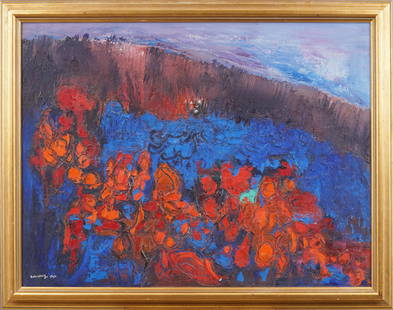
Rare and unique marble sculpture heads, Ruins of Carthage. 1st century after Christ Outstanding
Similar Sale History
View More Items in PaintingsRelated Paintings

More Items in Paintings
View MoreRecommended Art
View More


Item Details
Description
Rare and unique marble sculpture heads, Ruins of Carthage. 1st century after ChristOutstanding Universal ValueBrief synthesisFounded by the Phoenicians, Carthage is an extensive archaeological site, located on a hill dominating the Gulf of Tunis and the surrounding plain. Metropolis of Punic civilization in Africa and capital of the province of Africa in Roman times, Carthage has played a central role in Antiquity as a great commercial empire. During the lengthy Punic wars, Carthage occupied the territories that belonged to Rome, which then destroyed its rival in 146 AD. The town was rebuilt by the Romans on the ruins of the ancient city.Exceptional place of mixing, diffusion and blossoming of several cultures that succeeded one another (Phoenico-Punic, Roman, Paleochristian and Arab), this metropolis and its ports have encouraged wide-scale exchanges in the Mediterranean. Founded at the end of the 9th century BC by Elyssa-Dido and having sheltered the mythical love of Dido and Aeneas, Carthage produced a warrior and strategy genius in the person of Hannibal, the navigator-explorer Hannon, and a famous agronomist, Magon. Carthage has always nourished universal imagination through its historic and literary renown.The property comprises the vestiges of Punic, Roman, Vandal, Paleochristian and Arab presence. The major known components of the site of Carthage are the acropolis of Byrsa, the Punic ports, the Punic tophet, the necropolises, theatre, amphitheatre, circus, residential area, basilicas, the Antonin baths, Malaga cisterns and the archaeological reserve.Criterion (ii): Phoenician foundation linked to Tyre and Roman refoundation on the orders of Julius Cesar, Carthage was also the capital of a Vandal kingdom and the Byzantine province of Africa. Its antique ports bear witness to commercial and cultural exchanges over more than ten centuries. The tophet, sacred place dedicated to Baal, Baal, contains numerous stelae where numerous cultural influences are in evidence. Outstanding place of blossoming and diffusion of several cultures that succeeded one another (Phoenico-Punic, Roman, Paleochristian and Arab); Carthage has exercised considerable influence on the development of the arts, architecture and town planning in the Mediterranean.Criterion (iii): The site of Carthage bears exceptional testimony to the Phoenico-Punic civilization being at the time the central hub in the western basin of the Mediterranean. It was also one of the most brilliant centres of Afro-Roman civilization.Criterion (vi): The historic and literary renown of Carthage has always nourished the universal imagination. The site of Carthage is notably associated with the home of the legendary princess of Tyre, Elyssa-Dido, founder of the town, sung about by Virgil in the Aeneid; with the great navigator-explorer, Hannon, with Hannibal, one of the greatest military strategists of history, with writers such as Apulée, founder of Latin-African literature, with the martyr of Saint Cyprien and with Saint Augustin who trained and made several visits there.Integrity (2009)Although its integrity has been partially altered by uncontrolled urban sprawl during the first half of the 20th century, the site of Carthage has essentially retained the elements that characterise the antique town: urban network, meeting place (forum), recreation (theatre), leisure (baths), worship (temples), residential area, etc. The conservation of the site guarantees the maintenance of the intact character of the structures. However, it continues to face strong urban pressure that has, for the most part, been contained thanks to the national listing of the Carthage-Sidi Bou-Said Park.Authenticity (2009)Restoration and maintenancework carried out over the years is in accordance with the standards of international charters and has not damaged the authenticity of the monuments and remains of the site of Carthage. The site benefits from a maintenance protocol.Protection and management requirements (2009)The site of Carthage benefits from the listing of a large number of its remains as historic monuments (since 1885). Its protection is also guaranteed by Decree 85-1246 of 7 October 1985 concerning the listing of the Carthage-Sidi Bou-Said site, Law 35-1994 concerning the protection of archaeological and historic heritage and of traditional arts, and by the Order of 16 September 1996 for the creation of the cultural site of Carthage. A conservation unit attached to the National Heritage Institute is responsible for the safeguarding and management of the site. The management of the property is currently integrated into the urban development plan of the town. A Protection and Presentation Plan, presently under preparation, shall ensure the management of the site.
Condition
This is in excellent condition. Provenance available upon request. Private Collection.
Buyer's Premium
- 16% up to $10,000.00
- 11% above $10,000.00
Rare and unique marble sculpture heads, Ruins of Carthage. 1st century after Christ Outstanding
Estimate $30,000 - $35,000
2 bidders are watching this item.
Get approved to bid.
Shipping & Pickup Options
Item located in Chicago, IL, usOffers In-House Shipping
Payment
Accepts seamless payments through LiveAuctioneers

Related Searches
TOP




































































